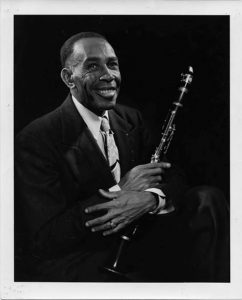George Lewis
George Lewis was a traditional jazz and brass band clarinet player, arranger, and bandleader from New Orleans.

Courtesy of Louisiana State Museum
George Lewis. Unidentified
A traditional jazz and brass band clarinet player and bandleader from New Orleans, George Lewis was an integral figure in the New Orleans jazz scene, playing with nearly every local musician in the genre at one point or another during his long and storied career. Many musicians would remember Lewis for giving them their first break in the music industry.
Born George Joseph François Louis Zenon in the French Quarter on July 13, 1900, Lewis came from Native American heritage on his father’s side. His mother, Alice Williams Zeno, was employed as a domestic worker for author Grace King. A self-taught clarinetist whose first instrument was a tin fife, Lewis was playing clarinet professionally with the Black Eagle Band of Mandeville while still in his teens. It was in Mandeville that he heard the Fritz family band play and was influenced by clarinetist Isadore Fritz. Soon he began playing with Buddy Petit’s Black and Tan Band, and when Petit and Earl Humphrey formed a new band, Lewis joined them on clarinet.
In the early 1920s Lewis formed his own group, which featured Henry “Red” Allen on trumpet. In 1928 he began performing with the Olympia Brass Band, although the Depression would force him to take on outside work as a stevedore. By this time, Lewis was already considered an accomplished player, having performed with Humphrey, Petit, Chris Kelly, and Kid Rena, as well as the Eureka, Kid Howard, and Original Zenith brass bands.
When the jazz historian Bill Russell wanted to record the legendary Bunk Johnson in 1942, Johnson chose Lewis as his clarinetist (Johnson and Lewis had performed together in Evan Thomas’s band in the early 1930s), which led to Lewis recording as a lead instrumentalist for the American label. Lewis played an engagement with Johnson in New York but soon returned to New Orleans without finishing the tour. In 1943 Lewis recorded for Climax. After his return to New Orleans, Lewis was seriously injured in a stevedore accident. During his convalescence, friends Lawrence Marrero (banjo) and Alcide Pavageau (string bass) brought their instruments to Lewis’s home in the French Quarter to be recorded again by Russell. “Burgundy Street Blues,” which became Lewis’s signature piece, is said to have come from these informal sessions.
In the late 1940s and early 1950s, Lewis was leader of yet another of his own bands, this one featuring the trombonist Jim Robinson. Media attention led Lewis to record regularly, and he soon found himself in demand. By this time, Lewis had become a major figure in the New Orleans jazz revival and had begun touring widely, even internationally to Europe and Japan. On one such tour, he entered an establishment in Japan dedicated entirely to him—every picture on the wall, every record on the jukebox featured George Lewis.
Lewis appeared at the Newport Jazz Festival in 1957 and was a regular at Preservation Hall, recording and touring widely with the Preservation Hall band. His mellow, clear sound and playing style are remembered and emulated by many.
Lewis died on December 31, 1968.
